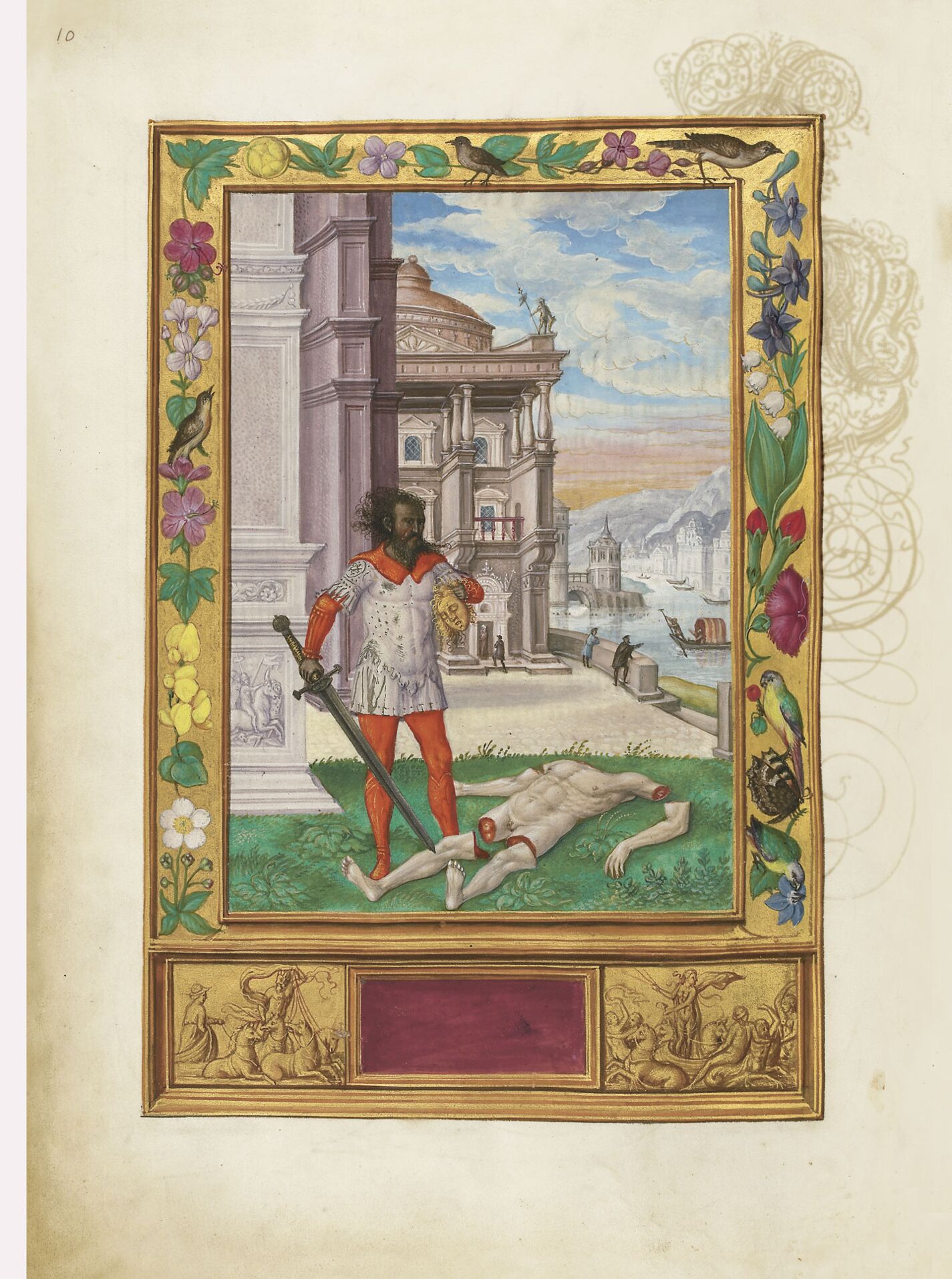A dark man with wild hair on his head and a sinister, hirsute face clutches a golden head in his left hand; its facial expression paralysed by fear, the severed head bears a striking iconographical resemblance to the Medusa. In his right hand, the man grasps an enormous sword with which he points towards the corpus delicti: for lying in the grass is the naked body of a fair-skinned man, his head, arms, and legs severed from the trunk. As though petrified at the moment of death, the limbs lie scattered around the torso on a grassy area marking the site of this brutal dismemberment. The plot unfolds before an architectural backdrop reminiscent of Venice. Architectural set pieces on the left embellish the scene, lending the picture a pseudo-ancient quality overall.
There are many mythical and religious pendants to this motif of ritual beheading and dismemberment, such as the ancient Egyptian myth of Isis and Osiris, or the allegory of Merlin. Alchemy, too, accords the theme considerable importance, particularly in relation to the concept of “dying and becoming”. A parallel motif can be found in the Aurora Consurgens. Chemically speaking, it signifies calcinatio, a process of oxidisation through heating. Surprisingly, the painter of the Splendor Solis opted to omit the piece of notepaper in the butcher’s left hand, though it is mentioned at length in the text. No doubt his decision was guided by artistic concerns, as his manifest recourse to “classical” beheading iconography would suggest. Echoing among other things depictions of Judith holding aloft the head of Holofernes, here the protagonist similarly holds the sword in one hand and the head in the other. Yet the painter was also clearly inspired by a German woodcut for Virgil’s Aeneid in which the protagonist does not hold the head in his hand at all. Ultimately, then, the question of the omitted note remains unresolved.
Jörg Völlnagel
(Art historian, research associate at the Staatliche Museen zu Berlin)

A dark man with wild hair on his head and a sinister, hirsute face clutches a golden head in his left hand; its facial expression paralysed by fear, the severed head bears a striking iconographical resemblance to the Medusa. In his right hand, the man grasps an enormous sword with which he points towards the corpus delicti: for lying in the grass is the naked body of a fair-skinned man, his head, arms, and legs severed from the trunk. As though petrified at the moment of death, the limbs lie scattered around the torso on a grassy area marking the site of this brutal dismemberment. The plot unfolds before an architectural backdrop reminiscent of Venice. Architectural set pieces on the left embellish the scene, lending the picture a pseudo-ancient quality overall.
There are many mythical and religious pendants to this motif of ritual beheading and dismemberment, such as the ancient Egyptian myth of Isis and Osiris, or the allegory of Merlin. Alchemy, too, accords the theme considerable importance, particularly in relation to the concept of “dying and becoming”. A parallel motif can be found in the Aurora Consurgens. Chemically speaking, it signifies calcinatio, a process of oxidisation through heating. Surprisingly, the painter of the Splendor Solis opted to omit the piece of notepaper in the butcher’s left hand, though it is mentioned at length in the text. No doubt his decision was guided by artistic concerns, as his manifest recourse to “classical” beheading iconography would suggest. Echoing among other things depictions of Judith holding aloft the head of Holofernes, here the protagonist similarly holds the sword in one hand and the head in the other. Yet the painter was also clearly inspired by a German woodcut for Virgil’s Aeneid in which the protagonist does not hold the head in his hand at all. Ultimately, then, the question of the omitted note remains unresolved.
Jörg Völlnagel
(Art historian, research associate at the Staatliche Museen zu Berlin)